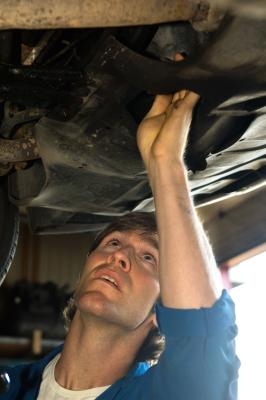
The undercarriage of an automobile is designed to protect parts from physical damage. Skid plates and cross members are strategically integrated into the car's design to prevent road debris or potholes from damaging important motor components. However, damage can occur regardless of how well an automobile is designed, and when damage occurs, the parts must be removed in order to be repaired.
Raise the vehicle's front end using automotive ramps or a rolling floor jack and jack stands. The front of the vehicle must be raised to give the mechanic a workable area underneath the vehicle.
Remove the oil drain plug and drain the existing motor oil on the vehicle. Also remove the vehicle's oil filter, which will be replaced at the end of the repair. Disconnect the negative (ground) cable from the Stratus' battery.
Visually inspect the oil pan, and visually inspect the entire perimeter of the Dodge Stratus' oil pan. The oil pan is bolted to the bottom of the engine block, and provides the oil bath for the motor's crank shaft. On some vehicles the bolts that fasten the oil pan to the motor block are accessible around the entire perimeter of the oil pan. In other models the bolt heads can be obscured under structural parts. Because the Stratus is a front wheel drive vehicle, the front of the car features the engine, the transaxle, CV joints, and drive axles. These parts may need to be removed in order to access the oil pan.
Support the engine with a engine lift or hoist. In many Stratus models, the engine mounts must be disconnected and the motor raised in order to gain the needed access to the oil pan.
Disconnect the motor mounts and the transmission mounts in order to lift the engine. The Stratus' engine must be raised high enough for the oil pan to drop off the engine block, and slide toward the rear of the vehicle as it is removed.
Remove any other structural cross members from the bottom side of the vehicle that could inhibit removal of the oil pan. Repairing the oil pan involves, first of all, removing the pan from the vehicle. Any structural member which blocks access to the pan or the bolts must be removed. On the Stratus, check the starter motor. It may have to be removed as well.
Remove the bolts from around the entire perimeter of the pan. First loosen every bolt, and confirm that each bolt can be accessed and easily removed. Then remove the bolts entirely and drop the pan off the bottom of the vehicle.
Clean the oil pan thoroughly with commercial degreaser. Repairs cannot be performed to the surface of an oil pan that is greasy or has an oily residue.
Use the stiff-edged putty knife to remove the oil pan gasket from the edge of the oil pan. Visually survey the bottom of the engine block. Remove any old oil pan gasket that may be stuck to the engine block as well.
Visually inspect the damage to the oil pan. A dent in the oil pan can often be popped back out without damaging the pan. Cracks, perforations, or holes in the oil pan must be repaired.
If welding or other metal work is needed, take the oil pan to a commercial welding shop and have any cracks or holes repaired. Adhesive repair kits, such as those that employ Bondo, fiberglass, or epoxy adhesives, will not permanently repair the oil pan. The high temperatures, vibrations, and oily conditions present in and around the vehicle's oil pan will cause any adhesive or chemical-based repair compound to fail. The damaged pan must be welded or braised or the entire pan must be replaced.
Clean the oil pan gasket mounting surfaces with commercial degreaser on both the pan and the engine block after the pan is repaired. In order for the replacement oil pan gasket to adhere properly, it must be mounted to a clean surface. Apply the oil pan gasket to the oil pan according to manufacturer's instructions. Then apply a bead of Permatex gasket material to the gasket according to the manufacturer's instructions.
Press the oil pan onto the bottom of the engine block, align the holes, and insert two or three bolts around the perimeter of the pan by hand. Tighten these bolts finger tight to hold the oil pan in place. Insert the rest of the bolts around the perimeter of the pan, and tighten all of them finger tight before tightening any of them with a wrench. This process will help the oil pan gasket seat properly to the engine block.
Tighten the bolts around the oil pan. Replace any structural cross members that may have been removed from the vehicle. Lower the motor back into place, and replace the Stratus' motor mounts and transmission mounts.
Replace the oil filter with a new filter and fill the crankcase with the manufacturer-recommended amount of oil. Allow the oil pan gasket to cure according to manufacturer's instructions before starting the vehicle. Replace the ground wire to the battery and starter motor, and the Stratus is ready to start up.